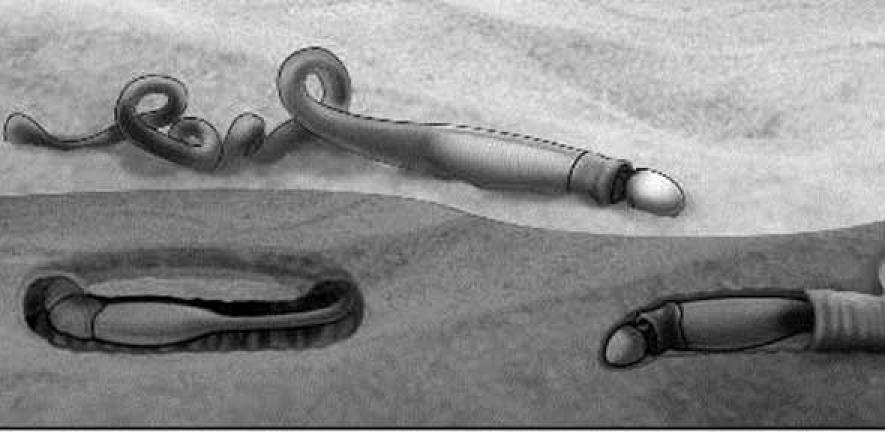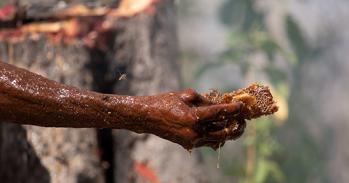
Fossils of a creature that lived on the ocean floor 505 million years ago have been identified by scientists as those of a previously-unknown marine worm, now named as Spartobranchus tenuis.
Fossils of a creature that lived on the ocean floor 505 million years ago have been identified by scientists as those of a previously-unknown marine worm, now named as Spartobranchus tenuis.
This is a particularly exciting find because not only does this fossil provide a vital link between two strikingly different groups, but it also has a bearing on the early evolution of a major phylum - the deuterostomes.
Professor Simon Conway Morris
The identification of curiously-shaped fossil of a marine worm found in Canada as a new species has pushed the record of the group to which it belongs back by 200 million years and helped to solve an evolutionary puzzle.
The research, which is published online today by the journal Nature, was carried out by a team of scientists from Canada and the UK. They examined numerous specimens, some of which were collected more than a century ago and are now held in the Smithsonian Institution (Washington, DC), along with new material recently collected by the Royal Ontario Museum (Toronto).
The newly-identified species comes from the Burgess Shale beds, located in Yoho National Park in the Rocky Mountains of British Columbia, an area that boasts one of the world’s most important fossil-rich deposits. The fossil shows that the acorn worm group – members of which thrive today in fine sands and mud – was living 505 million years ago when the mountainside shale in which it was discovered was under the ocean.
Named Spartobranchus tenuis, the species was previously unknown to science and its survival as a fossil is remarkable. It belongs to a group of animals known as enteropneusts – spaghetti-shaped creatures with soft bodies which in normal circumstances deteriorate rapidly – and dates from the Cambrian period.
The Cambrian is a key interval in the history of life because it is the time of an extraordinary evolutionary event known as the Cambrian “explosion”. This event has attracted widespread scientific attention from the time of Darwin because it not only represents a remarkable evolutionary radiation of animals, but geologically was surprisingly rapid.
The fossil was identified by a team including renowned palaeontologist Professor Simon Conway Morris of the University of Cambridge. Professor Conway Morris said: “This is a particularly exciting find because not only does this fossil provide a vital link between two strikingly different groups, but it also has a bearing on the early evolution of a major phylum - the deuterostomes - to which we humans also belong.”
The somewhat phallic-like shape of Spartobranchus tenuis is a reflection of its anatomy, but dramatically confirms its assignment to the group known as the enteropneusts. Detailed analysis of the fossil suggests that the creature had a flexible body consisting of a short proboscis, collar, and narrow elongate trunk terminating in a bulbous structure that may have served as an anchor on the sea bed.
A crucial element in the new identification is the observation of the gill slits, a key feature of not only the enteropneusts but also many other deuterostomes. The largest complete specimens examined were 10 cm long with the proboscis accounting for around 0.5 cm. A large proportion of the worms were preserved in tubes, of which some were branched, suggesting that the tubes were used as a dwelling structure.
Enteropneusts are hemichordates, a group of marine animals closely related to today’s echinoderms, best known as the sea urchins and star fish. Ever since their discovery in the 19th century, hemichordates have intrigued evolutionary biologists who have focused on the group’s origins and puzzled over the similarities and differences in its two main branches: enteropneusts and pterobranchs.
Interestingly, enteropneusts and pterobranchs look very different in as much as enteropneusts are worms whereas the pterobranchs typically are much smaller and live in colonies. Despite this, they share many genetic and developmental characteristics. Significantly, Spartobranchus tenuis has a vermiform (worm-like) body, characteristic of the enteropneusts, but can inhabit a tube in the same manner as the pterobranchs. Thus it represents a missing link connecting the two groups and helps to explain how an important evolutionary transformation took place.
Professor Conway Morris said: “Of crucial importance is the recognition of the fact that these animals are certainly enteropneusts but sometimes inhabit tubes that provide a vital link to their otherwise very different relatives, the pterobranchs, which are best known in the form of the now-extinct graptolites.”
The Burgess shale is one of the most important fossil deposits for understanding the origin and early evolution of animals that took place during the Cambrian explosion starting around 542 million years ago.
Nearly all the material obtained from the Burgess Shale is kept in Toronto and Washington DC, but an excellent display of specimens from this deposit can be seen on display in the Sedgwick Museum (Department of Earth Sciences). https://sedgwickmuseum.cam.ac.uk/
The members of the research team were: Dr Jean-Bernard Caron of the University of Toronto and the Royal Ontario Museum, Dr Christopher Cameron from the University of Montreal and Professor Simon Conway Morris from the University of Cambridge.
This work is licensed under a Creative Commons Licence. If you use this content on your site please link back to this page.





